Transcription of Halogens and Halides – Jan 08 - Circuitnet
1 Halogens and Halides Jan 08 There s been a lot of buzz lately about halogen -free and halide-free products. But what do halogen -free and halide-free actually mean? What exactly are Halogens and Halides ? Why do we want to get rid of them? Wait - before we get rid of them, why do we use them in the first place? I wanted to find out more about these families of chemicals that are getting so much attention. I m a mechanical engineer, and chemistry was never my strongest suit. When I hear the term halogen , I think of automobile headlights with brighter, more focused beams, not flame retardants that contain bromine.
2 But with all the talk about halogen -free and halide-free, I felt compelled to ask a couple of chemists exactly what this meant. Of course, I didn t understand their first explanation. So I asked them to rephrase their explanation in more basic terms, and they did. We went through this cycle a couple times. Eventually, I got it. It s actually quite simple, when you get right down to it. But I figured I m not the only assembly engineer who has forgotten more then they remember about basic chemistry, so this month s lesson learned is more or less a gear head s guide to Halogens and Halides , with a quick flash-back to high school chem class.
3 halogen or halide? A halogen is an element in the 7th column of the periodic table, which includes fluorine, chlorine and bromine. Iodine and astatine complete the group, but are not the subjects of primary consideration for electronics manufacturers. Elemental Halogens have seven valence electrons and are very reactive. In their quest to obtain an 8th electron, Halogens can be very strong oxidizing compounds. Once a halogen does obtain that 8th electron, it picks up a net negative charge and becomes a halide.
4 Having the net negative charge makes the halide compound ionic . A common example is table salt: Na+Cl-. Some readers may also be familiar with the similar term halite, spelled with a t as opposed to a d. Halite is the mineral form of NaCl that s also known as rock salt. It s regularly used in winter climates to melt snow and ice from walkways and roadways. Where and why are they used? In broad terms, Halogens are associated with PWBs and components; while Halides are associated with soldering operations.
5 But that s generally speaking, and there are exceptions to the rule. For the most part, halogenated compounds are found in printed circuit boards, solder masks, mold compounds, connectors, cable insulation and wiring conduit. They are used because they offer flame retardant properties to otherwise flammable plastics. The 1979 ban on Polychlorinated Bis-Phenols (the other meaning of the abbreviation PCB) gave way to the use of brominated organic compounds in their place. Now some of these Brominated Flame Retardants (BFRs) may face a fate similar to their predecessors.
6 Some halogenated compounds have already been replaced with halogen -free products; others are slated for removal and replacement over the next several years. Bear in mind that not all halogenated compounds are toxic. Consider the example of table salt: ingestion of excessive quantities may not be advisable, but it is certainly not considered a toxic substance. Here s one of the exceptions I mentioned: non- ionic halogenated compounds can also be used as raw materials in soldering fluxes to help keep the activators working as the process temperature increases, but they are used in far smaller quantities than in boards or components, and their inclusion is not an absolute necessity.
7 Wave soldering fluxes that are designed to withstand extended thermal cycles may likely contain Halogens , but some of today s most successful lead-free wave soldering fluxes and solder pastes do not. Inclusion of Halogens in flux materials is determined by the desired performance characteristics of the flux itself, and is usually fixed early in the product development cycle. If a flux is to be halogen -free, its basic composition must consider the absence of Halogens , and other ingredients in the formulation must be selected accordingly.
8 Although Halogens are sometimes included in fluxes, Halides are the compounds most commonly associated with them. While Halogens can be added to improve a flux s thermal robustness, Halides are added because they can rapidly reduce metal oxides and, in combination with a variety of organic acids, make ideal activator systems. But they have been cited as possible sources of post-soldering corrosion, so manufacturers of high performance and harsh environment electronics traditionally avoid them if they run no-clean processes.
9 On the other side of the assembly spectrum, manufacturers of more cost-sensitive systems often prefer fluxes that include Halides . The halide-containing fluxes provide better wetting during soldering - and therefore more mechanically reliable solder joints - on the lower cost components and boards that are more likely to exhibit solderability problems. Because Halides can be associated with post-solder corrosion, no-clean fluxes that contain Halides will always contain rosin to encapsulate any leftover, unreacted ionic material and insure electrochemical reliability.
10 Here s the other exception I mentioned: Halides are often used in the etching, plating, and final finishing processes of PWB fabrication. They can sometimes be found as residual contaminants on bare circuit boards if the completed boards were not cleaned properly by the fabricator. If completed assemblies demonstrate ionic contamination issues, it is wise to check the bare boards to understand if the source of the contamination is in the fabrication or the assembly process.









